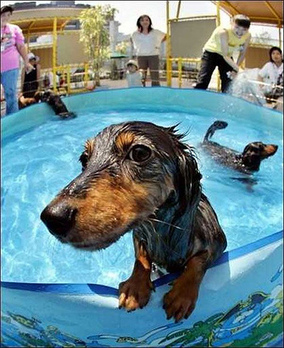Believe it or not, not all dogs are designed to swim. Learn whether your dog can swim naturally or need some help.
Some dogs are bred to get right in the water. Dogs that are bred to retrieve, have the name "water" in their breed name will most likely take to the pool like a duck to water. Some examples of natural born swimmers include
- Akita
- American Water Spaniel
- Barbets
- Chesapeake Bay
Retrievers - English Setter
- Golden Retrievers
- Hungarian pula
- Irish Setter
- Irish Water Spaniel
- Kerry blue terrier
- Labrador Retriever
- Newfoundland
- Spanish Water Dog
- Schipperke
- Standard Poodle
On the other hand, some breeds will sink before they swim. They are generally characterized with short legs and a heavy body type. These dogs need a flotation device to keep them safe if you are near a large body of water. Dogs with heavy bodies or shortlegs include:
- Basset Hound
- Boston Terrier
- Bulldog
- Dachshund
- Pug
- Scottish Terrier
- Welsh Corgi
- Take the dog to an area where there is not a lot of noise. This could be a quiet pool or the shallow part of a lake. Dogs will have difficulty concentrating or may get nervous if there is a lot of noise and activity nearby.
- Put the lifejacket on the dog. While it is not required, it allows the human helper to take their hands off the dog during the lessons without fear of drowning. It also prevents accidental drowning in later lessons if a dog is in the water without a helper swimming nearby.
- Enter the pool or shallow lake. If the dog is learning to swim in the pool, first acquaint him with the entrance to the pool. Continually put him in the pool at the same spot and help him walk down steps if there are any.
- Hold the dog's midsection and hindquarters and allow him to paddle using all four legs. Make sure he is not just using his front two legs -- otherwise he will sink on his own. It should look like he is running. His rear end should extend up and his neck should point down. Using food as a reward may help get him into this position.
- Continue the lesson for another 10 minutes. Use rewards to show good behavior and talk using an upbeat and positive voice.
- Show the dog how to exit the pool or shallow lake. This is especially important in the pool since getting out using steps or a ramp may be the easiest or only way for the dog to exit. Spend time reinforcing the exit process.
- Wash the dog off with shampoo after the swimming lessons. Dry out his ears and check his eyes for irritation from the chlorine as well.
- Take the dog to an area where there is not a lot of noise. This could be a quiet pool or the shallow part of a lake. Dogs will have difficulty concentrating or may get nervous if there is a lot of noise and activity nearby.









 RSS Feed
RSS Feed




